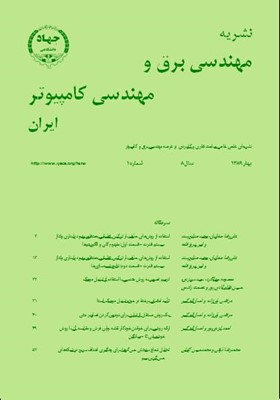تحليل شعاع سنجش حسگرها براي رهگيري اهداف سريع در شبكههاي حسگر بيسيم
محورهای موضوعی : electrical and computer engineeringمحمدرضا ذوقی 1 * , محمدحسین کهایی 2
1 - دانشگاه علم و صنعت ايران
2 - دانشگاه علم و صنعت ايران
کلید واژه: شبكههاي حسگر بيسيم رهگيري هدف سريع همبستگي مكاني,
چکیده مقاله :
در شبكههاي حسگر بيسيم با توجه به آرايش متراكم حسگرها و مسأله افزونگي اطلاعات، نيازي به فعالبودن تمام حسگرها در هر لحظه نيست. در اين مقاله، بهدنبال انتخاب مجموعهاي از حسگرهاي فعال هستيم كه اولاً انرژي مصرفي در شبكه كنترل گردد و ثانياً خطاي رهگيري يك هدف متحرك از حداكثر مقدار مجازي تجاوز ننمايد. بدين منظور تابع هزينهاي بر مبناي همبستگي مكاني تعريف شده، از الگوريتم Spatial - Split بر مبناي ويژگيهاي دو پارامتر مؤثر در همبستگي مكاني جهت انتخاب حسگرها و از روش تخمين نامتمركز بر مبناي فيلتر اطلاعات توسعهيافته براي رهگيري هدف استفاده ميشود. در ادامه اثر سرعت هدف در انتخاب حسگرهاي فعال و رهگيري هدف بررسي شده و سپس راه حلي براي كاهش خطاي رهگيري بر مبناي افزايش ميزان همپوشاني ناحيه سنجش واقعي و ناحيه سنجش تخميني پيشنهاد ميگردد. نتايج شبيهسازي نشان ميدهد كه دقت رهگيري نه تنها قابل مقايسه با روشهاي تخمين بهينه است، بلكه از ساير الگوريتمهاي انتخاب حسگر خطاي رهگيري كمتري دارد. در عين اين كه با انتخاب تعداد محدودي از حسگرها انرژي مصرفي شبكه نيز كاهش مييابد.
In this paper, we propose a new approach for selection of subsets of active sensors with some constraints on energy consumption and estimation error for tracking of a target. The proposed approach exploits the decentralized estimation by using the extended information filter for target tracking. Furthermore, a cost function is defined using spatial correlation for sensor selection. Consequently, the Spatial Split algorithm is proposed based on spatial correlation coefficients for sensor selection. At last, for high speed targets, we propose a modification on spatial split algorithm by changing the sensing range with respect to the target speed. Simulation results show that the tracking accuracy is analogous to those of optimal estimation methods. It is also found that energy consumption decreases due to activating only necessary sensors.
[1] J. W. Gardner, V. K Varadan, and O. O. Awadelkarim, Microsensors, MEMS, and Smart Devices, New York: Wiley, 2001.
[2] C. Y. Chong, S. Mori, and K. C. Chang, "Distributed multitarget multisensor tracking," in Multitarget Multisensor Tracking: Advanced Applications, Y. Bar - Shalom, ed., Norwood, MA: Artech House, pp. 247-295, 1990.
[3] V. Raghunathan, C. Schurgers, S. Park, and M. B. Srivastava, "Energy-aware wireless microsensor networks," IEEE Signal Processing Magazine, vol. 19, no. 2, pp. 40-50, Mar. 2002.
[4] H. Wang, K. Yao, G. Pottie, and D. Estrin, "Entropy - based sensor selection heuristic for target localization," in Proc. of 3rd Int. Symp. on Information Processing in Sensor Networks (IPSN), Berkeley, pp. 36-45, Apr. 2004.
[5] M. R. Zoghi and M. H. Kahaei, "Decentralized target tracking in collaborative sensor networks by using sensor selection scheme," in Proc. 12th Int. Computer Conf. of CSI, Feb. 2007.
[6] M. C. Vuran and I. F. Akyildiz, "Spatial correlation-based collaborative medium access control in wireless sensor networks," IEEE/ACM Trans. on Networking, vol. 14, no. 2, pp. 316-329, Apr. 2006.
[7] M. R. Zoghi and M. H. Kahaei, "Sensor selection for target tracking in WSN using modified INS algorithm," in Proc. 3th Int. Conf. on Information & Communication Technologies: from Theory to Applications, ICTTA, pp. 1-6, May 2008.
[8] M. R. Zoghi and M. H. Kahaei, "Sensor selection in WSN using spatial split algorithm for target tracking," in Proc. 13th Int. Computer Conf. of CSI, Mar. 2008.
[9] A. Goel and D. Estrin, "Simultaneous optimization for concave costs: single sink aggregation or single source buy-at-bulk," Algorithmica, vol. 43, no. 1-2, pp. 5-15, Aug. 2003.
[10] A. Deshpande, C. Guestrin, S. Madden, J. Hellerstein, and W. Hong, "Model driven data acquisition in sensor networks," in Proc. 30th Int. Conf. on Very Large Data Bases, VLDB, pp. 588-599, Sep. 2004.
[11] L. Doherty and K. Pister, "Scattered data selection for dense sensor networks," in Proc. of IPSN’04, pp. 369-378, Apr. 2004.
[12] M. C. Vuran, B. Akan, and I. F. Akyildiz, "Spatio-temporal correlation: theory and applications for wireless sensor networks," Computer Network, vol. 45, no. 31, pp. 245-259, Jun. 2004.
[13] J. Chou, D. Petrovic, and K. Ramchandran, "Tracking and exploiting correlations in dense sensor networks," in Proc. Conf. 36th Asilomar Conf. on Signals, Systems and Computers, vol. 1, pp. 39-43, 3-6 Nov. 2002.
[14] K. Whitehouse and D. Culler, "Calibration as parameter estimation in sensor networks," in Proc. of WSNA’02, pp. 59-67, Sep. 2002.
[15] A. G. O. Mutambara, Decentralized Estimation and Control for Multisensor Systems, Boca Raton, FL: CRC, 1998.
[16] H. V. Poor, An Introduction to Signal Detection and Estimation, Second ed. New York: Springer - Verlag, 1994.
[17] Y. B. Shalom and X. Li, Estimation and Tracking, Artech House, 1993.
[18] T. Clouqueur, V. Phipatanasuphorn, P. Ramanathan, and K. Saluja, "Sensor deployment strategy for target detection," in Proc. ACM WSNA 2002, pp. 42-48, Atlanta, US, Sep. 2002.
[19] T. Vercauteren and X. Wang, "Decentralized sigma-point information filters for target tracking in collaborative sensor networks," IEEE Trans. on Signal Processing, vol. 53, no. 8, pp. 2997-3009, Aug. 2005.
[20] T. Rappaport, Wireless Communications: Principles and Practice, Second Ed. Englewood Cliffs, NJ: Prentice - Hall, 2002.

